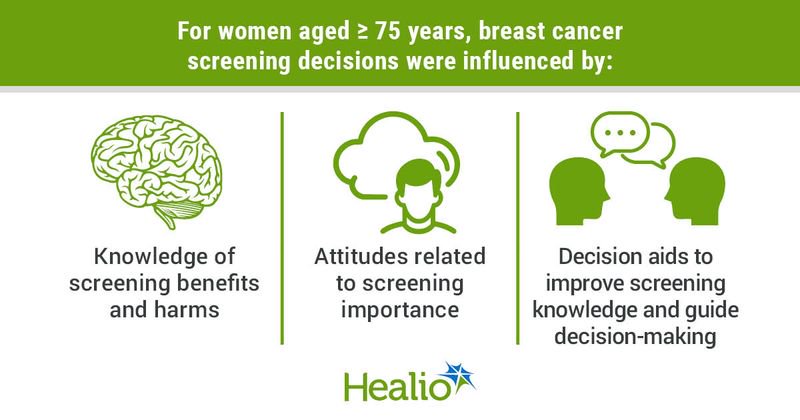Many women aware of importance, open to continuing breast cancer screening after age 75
Click Here to Manage Email Alerts
Key takeaways:
- Breast cancer screening decisions were influenced by knowledge, attitudes and decision aid exposure.
- Many women saw mammography as important and wished to continue screening beyond age 75 years.
Many women aged 75 years and older are aware of the importance of breast cancer screening and desire to continue screening regardless of health status or age, according to a scoping review published in BMC Women’s Health.
“Very few studies have been undertaken to understand the motivations of women to screen or to establish screening participation rates among women aged 75 and older,” Virginia Dickson-Swift, PhD, senior research fellow at the Violet Vines Centre for Rural Health Research at La Trobe Rural Health School at La Trobe University, Australia, and colleagues wrote. “This is surprising given that increasing age is recognized as a key risk factor for the development of breast cancer, and that screening is offered in many locations around the world every 2 years up until age 74 years.”

Dickson-Swift and colleagues searched CINAHL, MEDLINE, Web of Science and PsychINFO and reviewed 14 research articles published since 2009 from the U.S., U.K. and France addressing motivation, intention and/or participation in breast cancer screening among women aged 75 years and older. All studies reported on women who used public and private breast cancer screening services and women who did not.
Three themes emerged from the studies regarding influences on breast cancer screening decisions:
- knowledge of breast cancer screening benefits and harms and their relationship to age;
- underlying attitudes related to breast cancer screening importance; and
- decision aid exposure to improve breast cancer screening knowledge and guide decision-making.
Women typically perceived mammography as a positive, beneficial and routine care component and an important aspect of caring for oneself, according to the authors. In addition, studies suggested that aging and poor health were not seen as reasonable reasons to stop breast cancer screening.
Three studies reported findings indicating that some women planned to continue breast cancer screening beyond age 75 years. One study from France noted that 60% of women aged 75 years and older reported wishing to continue screening, and 36% of women younger than 75 years who never underwent mammography reported wanting to do so in the future.
Decision aids may be effective in improving knowledge of the benefits and harms of breast screening as many women reported poor knowledge, according to the authors. A pilot study of eight women in the U.S. utilizing decision aids demonstrated that 62.5% of women planned to continue receiving mammography. In this study, agreeing that their physician would recommend mammography dropped from 80% to 62.5% after exposure to the decision aid. These results suggest that decision aids might result in fewer women continuing breast cancer screening beyond age 75 years.
“Further research regarding breast cancer screening motivations and behaviors for women over 75 would provide valuable insight for health providers delivering services to women in this age group. Health providers may benefit from the broader use of decision aids or structured checklists to guide conversations with women over 75 regarding ongoing health promotion/preventive measures,” the authors wrote. “Providing health-based information in nonclinical settings frequented by women in this age group may provide a broader reach of information and facilitate choices. This may help to reduce any perception of discrimination based on age, health status or sociodemographic factors.”
